The History of Memrise
Ed Cooke launched Memrise in 2010, along with other Co-founders Ben Whately and Greg Detre. Similar to Duolingo and Busuu, Memrise makes language studying a game through plenty of fun activities.
As you’d expect, Memrise is available on Android and iOS since 2013, and there is also a browser version.
After a decade of presence, the British language platform claims to have grown to over 40 million user bases in 189 countries.
It’s important to note that these are all-time total registered users since inception.
Regardless of whether the number is exaggerated or fact, the current monthly active users (MAU) would be significantly low.
I tried to practice some vocabulary on Memrise a few years back. I had the impression that one day it will become a surpassing platform for language enthusiasts.
They had the head start, funding, and all the elements to make that happen.
To my surprise, it hasn’t changed enough today. The critical updates are still missing. The user interference design and features all look the same.
It is Déjà vu all over again.
The expected improvement and innovations haven’t happened yet, and that is an enormous disappointment.
What is Memrise?
In its essence, Memrise is a flash-card app. In its oldest classical form, this is a piece of paper with a word or phrase in your target language written on one side and the translation written on the other.
It’s mainly focused on studying languages online. Still, you can also use the app to memorize and practice words from other subjects and fields.
To sum up, this is a vocabulary-learning tool, and Memrise perfects it with the modern technology.
Memrise ingrains unfamiliar words and phrases into your brain by using mnemonics and spaced repetition, which they show through planting flowers.
You will see unlearned vocabularies as seeds. Then, you plant them (i.e., learn) and finally turns them into a flower.
Suppose you desire to hone in on vocabulary and want to expand it further in the language of your choice. In that case, you can use ten-minute engaging exercises to drill new terms.
It helps you gain a basic knowledge of a foreign language.
How it works
Let us take a closer look at what using Memrise like.
The interface of both the website and the app is relatively intuitive. It is easy to see what you need to do, and you will get the hang of using the app after just a few minutes of clicking around.
If you need any assistant, you can check out the comprehensive FAQ section.
Similar to other popular language apps, signing up is free.
You can do it either using your email or with your account on Facebook or Google.
On the ‘Courses’ page, you can select the language you speak and the language you wish to study. Then, you will see all the courses available for this combination.
There are other categories available, such as Maths and Science or Trivia, but Memrise is primarily useful for language learning.
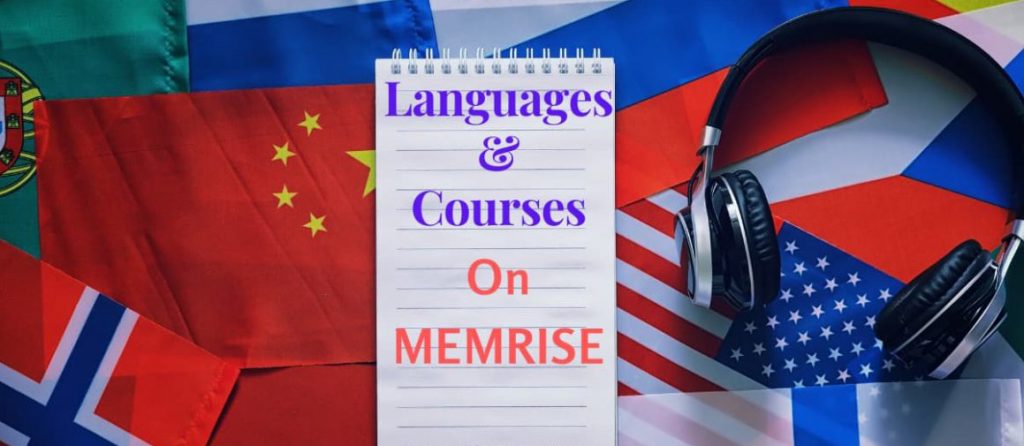
Courses Available on Memrise
There are two kinds of courses on Memrise — the official curated programs created by the Memrise staff and the user-created content developed by the Memrise community members worldwide.
The topics vary: some courses feature basic vocabulary for this or that level.
In contrast, others have a more focused approach, like ‘500 most common Portuguese words’, learning German conversation skills, or grammar from a particular Italian textbook.
Earlier, it was a member-driven-only platform where language-lovers, linguists, and teachers from far and wide used to make content for learners.
They eventually produced tons of great content for learners with a diverse combination of native and target languages.
As per the design, not all community courses are visible from the “Search” function within the Memrise mobile app.
You need to use the browser version to see the full range of the programs and modules available. It will be accessible in the app once you start practicing through the website.
Later, the Memrise team cultivated a variety of language learning products and kept user-designed content untouched.
They divided the entire official course into many levels, and each has several small-size lessons based on various topics.
If it does not satisfy you with any of the courses offered, you can create your own program. This feature is available in the browser version only.
You can also copy a deck to make your own by some modification as per your requirement.
Memrise can come in handy when you want to concentrate on learning the meanings of a particular set of words and phrases. For instance, vocabulary from a book you are reading or your favorite TV show and Movies.
Languages offered by Memrise
Memrise features an immense option for learners.
From popular foreign languages like French and Arabic to rarely taught tongues like Polish and Mongolian to some challenging languages, such as Cantonese and Persian, you have all the choices at your fingertips.
You can also learn Spanish dialects, for example, Mexican or the one from Spain, or learn Russian Cyrillic or one of the artificial and sign languages.
If we merge official and community-driven courses, it would be more than 200 language courses in dozens of different tongues.
Memrise offers lessons on Bahasa, Dutch, English, Korean, Chinese, Thai, Finnish, Japanese, Turkish, Vietnamese, Nordic languages, among many others.
The list is endless, and many are in development, too. Whatever you need, the chances are you will find one on Memrise.
Memrise won’t make you fluent in a foreign language, but it’s an excellent study aid. This web and mobile app goes a long way toward helping you memorize characters, vocabulary, and phrases. It’s not just for learning languages, either. Memrise also helps you study and learn math, science, economics, and other subjects—although language learning really is its main focus. Memrise is interactive, giving you exercises and quizzes, so it’s not just another flashcard app. The free tier of service is very good, making it one of our favorite free language learning apps and a PCMag Editors’ Choice winner. There’s a paid membership if you’re hungry for more.
How Much Does Memrise Cost?
To set up a Memrise account costs nothing at all. You do need an account to use the app, but you don’t have to give up any payment details. The free account gives you access to a good amount of content both in the web app and mobile apps, and there are no ads. But you get more ways to learn and additional features, such as offline access, by paying for a Pro subscription.
When we tested Memrise in April 2022, we saw a few different prices on the web and mobile apps. The standard rate according to the mobile app is $8.49 per month, $89.99 per year, or $119.99 (one-time payment) for lifetime access. We also saw promotions, which is common with language-learning apps. The listed deal price at the time of testing in the mobile app was $44.99 per year. Logging in on the web, however, we saw an offer as low as $29.99 per year—with the standard list price showing as $59.99 per year.
In short, if you are going to upgrade with Memrise, we recommend looking at all the options across both the web and mobile app to make sure you’re getting the best price.
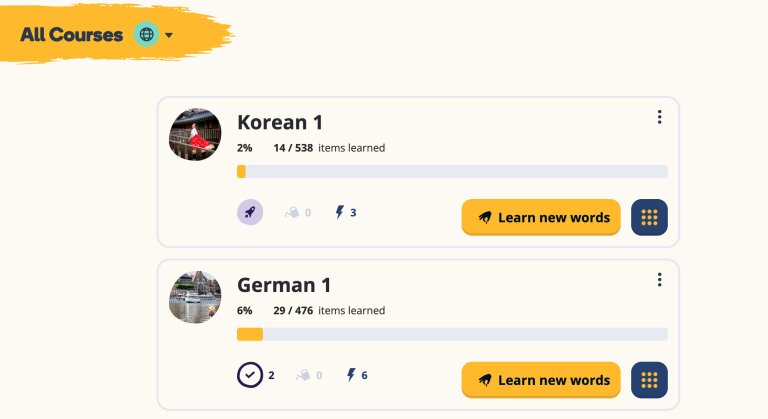
What does signing up for Memrise Pro get you? It unlocks all features, chief among them adaptive learning technology, meaning the app changes how it teaches you based on your performance. The Pro account also has some statistics that show when and how much you studied and access to Difficult Word exercises, meaning exercises that help you work on vocabulary that you’ve previously gotten wrong in Memrise.
How Much Do Other Language Apps Cost?
To gauge Memrise’s value, it helps to have a point of comparison. A good starting point is Duolingo. This app also has a great free tier of service and asks $12.99 per month or $83.88 per year for Plus.
Quizlet, another popular study app, was advertising a price of $35.99 per year, but that turned into $47.99 per year when we logged into our account, or $7.99 per month.
Full-service language learning apps that provide more rigorous instruction, such as Fluenz and Rosetta Stone, cost in the vicinity of $100–$200 per year.
What Languages Can You Learn With Memrise?
Memrise has content for both English speakers and speakers of other languages. Some of the most popular language courses for English speakers are Arabic, French, German, Italian, Japanese, Korean, Russian, and Spanish (European and Mexican). You can sign up for as many languages as you want, even if you’re a free user, just as you can in Duolingo.
Those languages are highlighted because of their popularity and because they have plentiful content that’s highly structured and developed in house by Memrise. For example, when studying Korean, you can start with courses called Korean 1, Korean 2, Korean 3, and so forth, and those numbered courses are created by Memrise rather than users of the service. For any course, the creator’s name is next to the name of the course. When you see that Memrise created a course, you can trust that it was vetted for quality.
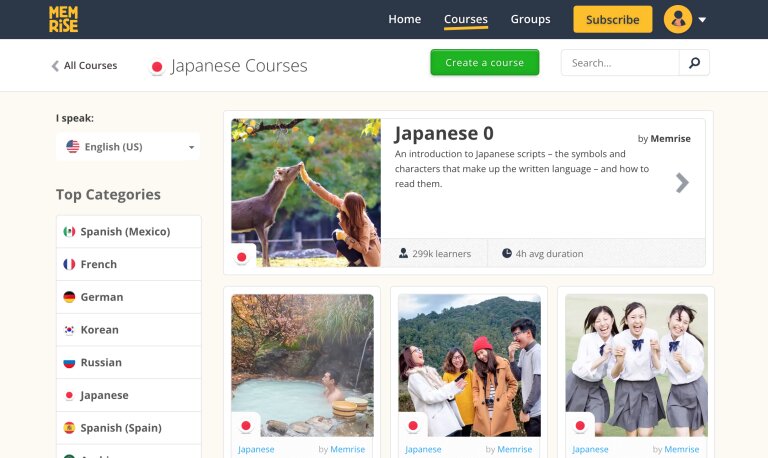
Beyond those basic courses in the languages I just mentioned, there are more specialized courses, like Slang in Korean and 1,000 Most Common Korean Words. These courses are not necessarily created by Memrise, so you have no assurance of their quality and accuracy.
Memrise hosts courses for many more languages than the ones I listed, but not all of them are made by Memrise. Additionally, the number of lessons varies a lot for each language. For example, I found more than 100 courses for Swahili, but none labeled Swahili 1, Swahili 2, and so forth. Another example: You have a range of options for learning the Armenian alphabet, but only a handful of options if you want to pick up a few words of Cherokee. I’m impressed by just how many languages are included, even if the quality and amount of content is inconsistent.
Features And Experience
Memrise looks polished and has a clear structure. When you start with a course of study, you start at the first lesson. All the following lessons in that course remain locked until you complete the prior lessons. The structure is great for beginners. While you can’t advance to new lessons without unlocking them, you can jump around to different courses at your leisure. That’s good for experienced speakers, though there’s no placement test for finding out the best place to start.
While Memrise lets you study a wide variety of topics, the language-learning content is what you see first. In testing the app, I went through some entry-level courses in Korean and German, plus more advanced courses in Spanish and Romanian. Memrise doesn’t limit the number of courses you can choose, even with a free account.
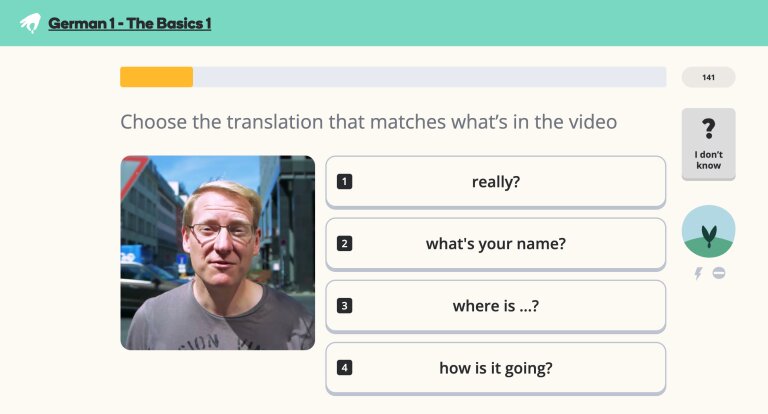
Memrise teaches material by first showing you a few words, characters, or concepts, depending on what you’re studying, and then quizzing you on them. For learning languages, the app uses both written and audio material. For example, the Korean program started by exposing me to a small selection of characters and showing their equivalent in written English as well as playing an audio file of a native speaker making the sound. After you see and hear the character a few times, Memrise starts peppering in multiple-choice questions in which you identify the characters you just learned.
Memrise encourages you to not learn too much at once, and it does a great job of recycling words and phrases you’ve already learned to keep them fresh in your mind. You can change the number of new items you learn per lesson (3, 5, 7 or 10) in the settings, which is helpful for learners who need to go faster or slower. You get similar controls for words per review session.
Learning From Zero
Learning Korean characters went smoother than I expected, although there’s not much you can do to remember new characters and their sounds other than to memorize them. Memrise shows you only a few characters in any lesson, and then slowly combines them into short words. Much of the time, a Korean speaker says the character and holds up a card showing it written, too, which makes it a little too easy to then choose the corresponding character from a multiple choice set.
The learning was solid, but slow. If you’re a quick learner, you might find Memrise a little tedious.
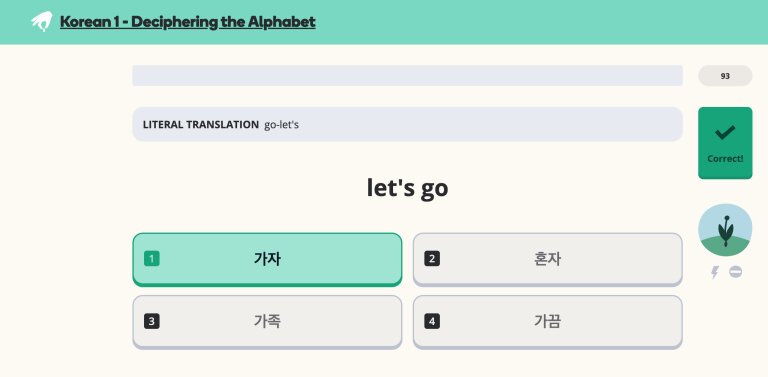
When I tried Memrise to practice languages I have a lot of experience speaking, the app felt exceptionally slow and often too easy. More experienced learners will find that Duolingo may have content to help them practice, but only for languages that have really long courses, as that’s where you’ll find exercises for intermediate and advanced learners. Otherwise I’d point you to Lingoda, which offers online classes for very fair prices. Lingoda has a placement test to help get you into the right level, and the hour-long classes are challenging.
Memrise has speed quizzes that let you test what you’ve learned so far in a timed environment. The quizzes are short, talking only maybe two minutes to complete. Everything about Memrise seems designed to be mobile-friendly.
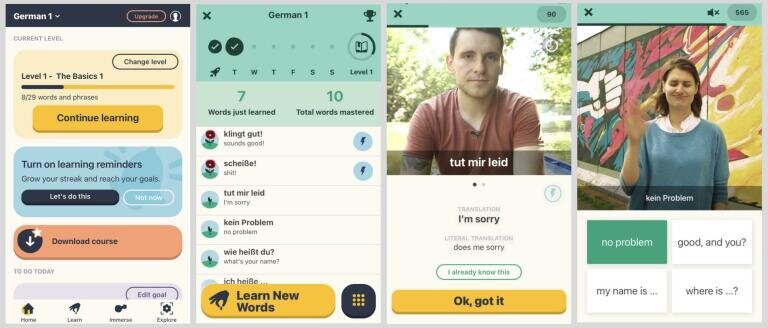
Memrise’s Mobile App vs. Web App
You can use Memrise as both a web app and mobile app for Android or Apple mobile devices. The web and mobile apps are not the same, however. As mentioned earlier, you might see different pricing for Memrise Pro in one place versus the other. Additionally, you can’t do grammar lessons in the web app. You need the mobile app for that.
If you like to switch between web and mobile, that’s fine, as Memrise does save your place in all the courses and syncs them across platforms. If you prefer to learn using the web app, you might find Memrise inconvenient.
Among the Best Free Language Study Apps
Memrise is a worthwhile app for studying languages, particularly for beginners learning new characters and basic vocabulary. The fact that it’s more than just a flashcard app keeps it engaging. We also appreciate that the free tier of service is ample and lets you study as many languages—and other subjects—as you want. You never feel like you’re hitting a paywall. While the Pro version offers extra features that serious learners might want to take advantage of, all the aspects of Memrise that make it great are included in the free version, and for that it’s an Editors’ Choice winner.



0 Comments